The next-gen MacBook Pro with Retina Display Review
by Anand Lal Shimpi on June 23, 2012 4:14 AM EST- Posted in
- Mac
- Apple
- MacBook Pro
- Laptops
- Notebooks
General Performance
The Retina MacBook Pro can complete a full boot from power off to usable desktop in just over 17 seconds. It’s a hair faster than last year’s MacBook Airs, a bit quicker than the old SSD equipped MacBook Pro, and night and day compared to any Mac with a hard drive. Four years ago I said that Solid State Drives were the single biggest upgrade you could do for your computer, and it couldn’t be any more true today.
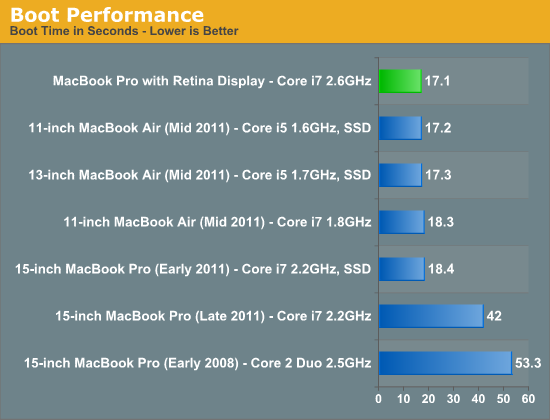
The Retina MBP behaves more like the 3rd gen MacBook Air in how it goes to sleep and wakes up. Both happen virtually instantaneously, and if your battery dies while asleep you don’t get the greyed out screen with progress bar as your environment is restored from disk - it just appears, taking a couple of seconds for the clock to update and everything else to come to life. It’s a small but subtle change that tells you the rMBP is in a distinctly different class. Apple’s tight control over firmware and storage interface help it deliver up to 30 days of standby power, a number I’ll really need to verify one of these days.
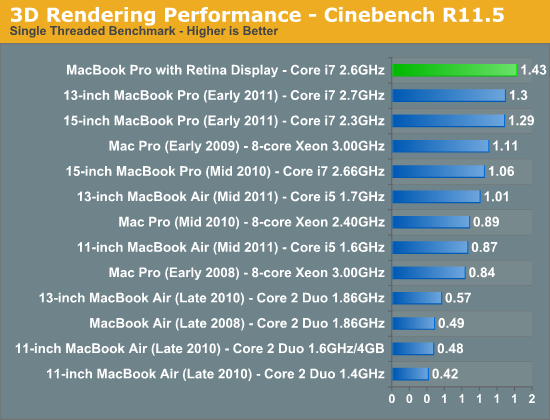
Raw CPU performance is up handsomely over the 2011 MacBook Pros, at least in their standard configurations. The 2.6GHz chip in the $2799 rMBP can turbo up to 3.6GHz when only a single core is active, delivering a 13% increase in performance over the previous generation 2.2GHz part. Compared to the upgraded 2.4GHz Sandy Bridge Core i7 from last year (not pictured) however, I would expect a sub-10% advantage.
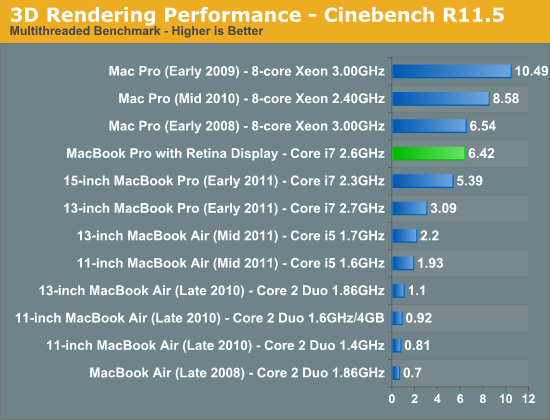
With all four cores active the 2.6GHz chip can run at up to 3.4GHz, which it regularly hits as long as the Kepler GPU stays asleep. The 2.2GHz Sandy Bridge based 2011s we’re comparing to on the other hand can only turbo up to 2.8GHz. Here the advantage is a more tangible 19%, although once again if you are comparing to one of the 2.4GHz parts from last year I would expect notably smaller gains (mid to high single digit percentages). The improved thermal characteristics may allow mobile Ivy Bridge to operate in turbo modes for longer than Sandy Bridge, however I don’t have any data to actually support that claim. That doesn’t mean it can’t happen, it’s just complex to test and model.
While the Cinebench tests are largely CPU bound, many of the following tests are largely influenced by the SSD in the Retina MacBook Pro. Here we see some huge gains, especially compared to older HDD based Macs.
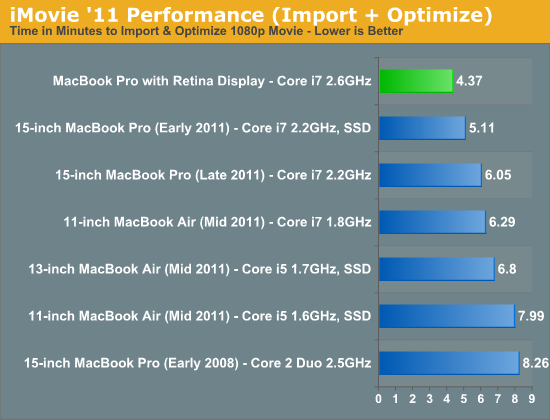
iMovie import time is heavily influenced by disk as well as CPU performance. As a result there are big improvements over both the HDD and SSD equipped 2011 MBPs.

Export time is more heavily CPU bound and here the advantage over the previous generation notebooks is pretty much nonexistent.
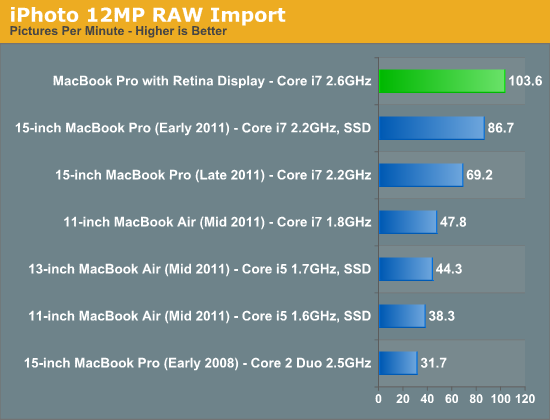
Our iPhoto import test stresses both disk and CPU, giving the rMBP a tangible advantage compared to the SSD equipped 2011 MBP. None of the dual-core or HDD based Macs stand a chance here.

Our Lightroom test continues the storage/CPU dependencies as only the SSD equipped 2011 MBP is able to come close to the rMBP’s performance. There’s not much of a performance advantage here when you compare similarly equipped systems though. Ivy Bridge may have been a good upgrade from a power standpoint, but it doesn’t tell a significantly different performance story in all cases.
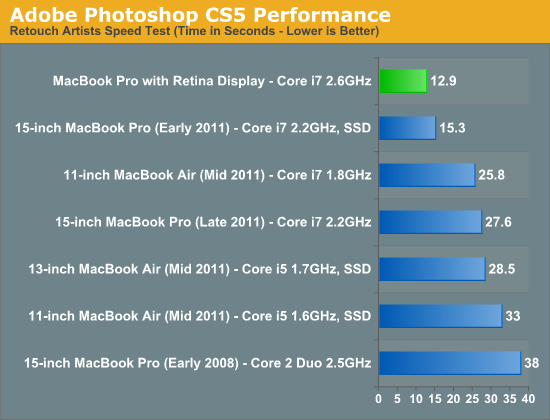
The rMBP cranks through our Photoshop workload fairly quickly. The performance advantages here are likely due to increased memory, a much faster SSD and obvious CPU speed improvements as well.
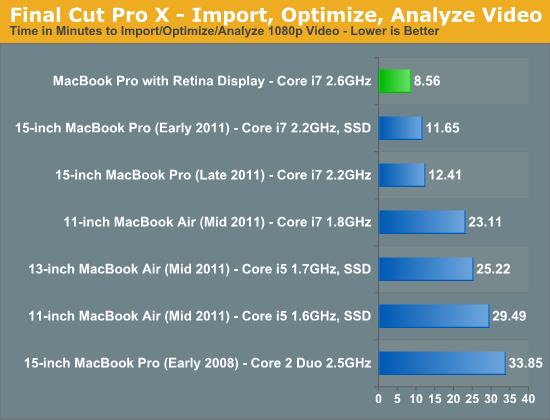
The same holds true for the advantages in our Final Cut Pro X test. As a default configuration the $2799 MacBook Pro with Retina Display is easily the fastest notebook Apple has ever shipped. It’s only if you had an upgraded 2011 model (perhaps with an aftermarket SSD?) that you’ll be unimpressed by the move.
I can’t stress enough how much the new SSD improves the overall experience. It’s just so much faster than what Apple used to ship.










471 Comments
View All Comments
dannyboy153 - Saturday, June 23, 2012 - link
The Sony Z is more of a "consumer" laptop than a creative laptop. Here's why:1) The 1080p (9x16) LCD is great for watch movies but the loss in 1" vertical height is annoying.
2) No discrete GPU built into the Laptop.
3) No high res output. VGA and HDMI doesn't cut it. I have no idea why their dock doesn't have DVI or display port even though it's equipped with a discrete GPU. Their implementation of the dock is admirable, but it's filled with bugs. Read the reviews.
I'll have to admit the MBP is heavier by almost 2x the weight of the Sony Z. But at ~4.5 lbs, it's not overly heavy. MBP advantage:
1) None of the disadvantages of 1-3 above.
2) 15.4" screen is HUGE for me (coming form an X200). Also, it's like the best of both worlds for glossy and matte LCDs; beautiful and vastly reduced glare.
3) The Sony Z has a quad core but the MBP is more powerful. Notice I didn't mention the weaker Quad core of the Sony Z as one of its disadvantage because I believe it's hard enough for them to even offer such power in their laptop.
ananduser - Saturday, June 23, 2012 - link
The 2010 VaioZ had discrete video, 1080p screen, quad raid SSD option. blu ray, slim profile, etc.The 2012 VaioZ does not have discrete built in, only via external dock.
So...considering what the Z was for 2010, Anand never sang such high praises for it. Why ? Because he's a macuser and couldn't care less about another company's efforts.
OCedHrt - Sunday, June 24, 2012 - link
http://www.anandtech.com/show/5430/sony-vaio-z-wit...They did eventually do a review of the 2011/2012 Z, however they're not as tolerant of small faults as they are with apple products.
I remember back in the day when Anand would wipe the floor about keyboards not having enough pitch. But on the macbook pro retina the reduced pitch is just "different" not terrible.
gstrickler - Sunday, June 24, 2012 - link
The MBP keyboard doesn't have reduced pitch, it's a standard 19mm pitch. It has slightly reduced key travel.OCedHrt - Monday, June 25, 2012 - link
Sorry I meant key travel. Incorrect use of terms on my part.dannyboy153 - Sunday, June 24, 2012 - link
For 2010, there were plenty of laptops with 1080p. Name one laptop now with the Apple's display. The Z is a great laptop if you're a consumer of media. But for creators, the Apple is superior.Spunjji - Monday, June 25, 2012 - link
Name another *13"* laptop in 2010 with 1080p. Go on. We can play this game all day!SanX - Saturday, June 23, 2012 - link
hdmi can not handle 1080 output?dannyboy153 - Sunday, June 24, 2012 - link
I don't consider 1080p hi res. At a minimum it has to be at least 1200p in 10x16 format for 24" monitors. For the price of the Sony Z, not being able to do 2560x1600 is a shame.OCedHrt - Monday, June 25, 2012 - link
Reading on forums there doesn't seem to be any issues with 1920x1200 external output, but 2560x1600 does not work without a hack for reduced refresh rate.